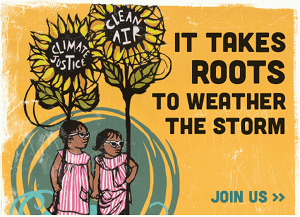
By Sanaz Arjomand
Why are an expected 100,000 people hitting the streets of New York City this Sunday? To learn more about the strategic thinking behind the upcoming People’s Climate March, the Bard Center for Environmental Policy sat down with 350.org’s U.S. Campus Field Manager, Jenny Marienau.
This Q&A is an edited excerpt from the National Climate Seminar. Bard CEP’s twice-monthly dial-in conversation features top climate scientists, policymakers and activists. The complete podcast of the interview is available here.
Bard CEP: What planted the seed for the People’s Climate March?
Jenny Marienau: About a year ago, United Nations Secretary General Ban Ki-moon called a meeting of world leaders to talk about solutions to the climate crisis. The People’s Climate March was planned as a way to take advantage of that national stage to demonstrate the power of the climate movement. We tried to bring together all of the different constituencies involved, to flex the climate movement’s muscle and let it see itself all together, marching in the street.
Bard CEP: How many people are participating?
Marienau: We’re hoping to be one of the largest marches in the climate movement’s history with upwards of 100,000 people participating. All 50 U.S. states will be represented at the march. There are 374 buses and trains listed to come to the march.
The march itself is a project of over 1,100 groups, including faith groups, climate action groups, groups of parents and public interest law centers. They have organized events all around the march as well as the march itself. Because it’s such a broad coalition, there isn’t one ask or one set of demands other than the very broad sentiment: “We want to see climate action now.”
Bard CEP: What was the process for building the coalition for the march?
Marienau: Folks with an interest in taking action on climate have come together in a series of groups. For example, a group from New York City with goals and asks for New York City came together and did some planning at their own table. There was also a youth table of folks who represent high school and college students and young organizers. Different interest groups coalesced to come up with their particular interests in the march. Then those tables of people came together to design the overall group march as part of an open call. The effort has been not to have 350.org leading the organizing of the march, just leaving space for a larger coalition to put it together.
Bard CEP: What will success at the People’s Climate March look like?
Marienau: For me, it will really be the quality of organizing that comes out of it. Yes, the march is a referendum on where the U.S. stands on climate action, but in terms of the power that we’re building, how we go to the march in coordinated groups and how we come out of it with clear next steps for our communities is the best measure of success.
Bard CEP: What past lessons learned have been applied here?
Marienau: One important lesson was learned in a fairly crushing way around [the] 2009 climate bill. Almost everyone in the nonprofit climate organizing sphere was putting all their energy into this bill that failed to pass. There was a vacuum created in that “all-in-one solution” type of organizing — because when your silver bullet fails to hit the target, what else is there? I think that’s where this patchwork style of organizing originated. We don’t have one solution to the climate crisis, and top-down solutions are not always the best option. Community-based solutions that really work for people in their hometowns are an important — maybe the most important — piece of our organizing.
Bard CEP: What should interested parties be doing between now and the march?
Marienau: Check out the People’s Climate March website. You can find events in your area or transportation shares to the march. Once you’ve figured out where you’re going and how you’re getting there, invite your friends, invite your faith community, invite everyone you know. Social media is a great way to spread the word, as are posters in coffee shops. Finally, decide who you want to meet and make a plan to do that; there are lots of events where you can network in a more focused way listed on the events board.
--
Bard CEP will be hosting an open house along the route of the People’s Climate March. If you would like to take a break from the march and get an “aerial view," please stop by our classroom at 1150 6th Avenue, 5th Floor, between 1:00 p.m. and 4:00 p.m.
The next edition of the National Climate Seminar, at noon eastern on September 24, features Dr. Robyn Smyth on “The Next Toledo: Algal Blooms and Climate Change." Click here for dial-in information.
--
Image credit: People's Climate March. Click here for more shareable graphics.
Sanaz Arjomand is a graduate student in the MS Environmental Policy Program at the Bard Center for Environmental Policy.
TriplePundit has published articles from over 1000 contributors. If you'd like to be a guest author, please get in touch!














